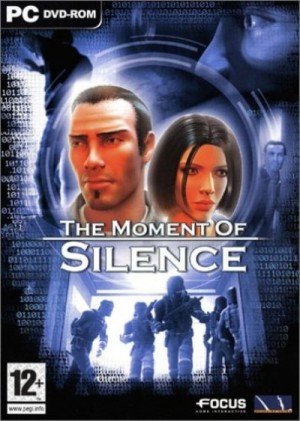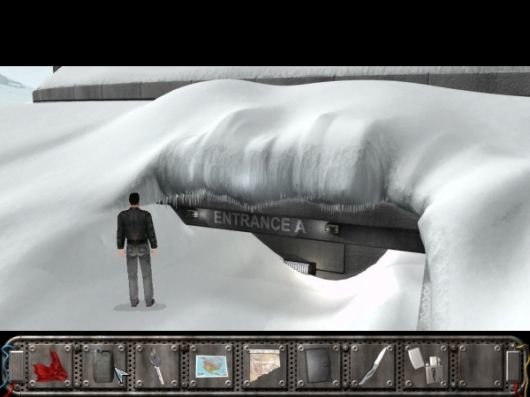Review for The Moment of Silence
Shhhh. Listen.
…
Can you hear it?
Silence.
According to Merriam-Webster’s dictionary, silence is “the absence of speech or noise.” Therefore a moment of silence would be a moment, in the middle of a possibly loud and zany day, when there is no speech or any kind of sound. It is in our nature as human beings often to resist silence. Silence makes people uncomfortable. When we speak, we often fill in the gaps with some noise, a grunt, an interrogative, an “ah,” an “oh,” maybe even a belch. As a teacher, I can see the fear of silence hover like a thick fog in the classroom. Ask a question, and silence follows. Some students tap their pencils; some shake their legs; others’ eyes wander aimlessly in search of a volunteer. The enigmatic and brooding nature of pure silence permeates House of Tales’ newest and second venture into the realm of adventure games in The Moment of Silence.
A typical American kid might wonder why a designer would make a game dedicated to a moment of emptiness, an entire game about an uncomfortable void dangling in the air. After a few hours with this game, however, I soon realized Martin Ganteföhr of House of Tales did not produce yet another waste of space, as seen in HoT’s fluffy first attempt, Mystery of the Druids. TMOS, instead, draws upon the foundations of an age-old Eastern adage, an adage much of our own culture could afford to understand: silence is not emptiness. Quite the opposite in fact; The Moment of Silence has substance. Lots of it.
The game opens up in the year 2044, after a night of drinking several heavy and hard substances, oddly enough. With a nagging hangover, you--as Peter Wright--awake to a disturbingly invasive police raid down the hall. You watch passively from behind a closed door, peering out safely through a peephole. A neighbor is shuffled away under the weight of a militaristic gun, leaving you baffled and mystified. Peter, a man in much need of spiritual guidance after the dramatic loss of his wife and child in a plane crash, decidedly breaks his neighborly silence and strives to uncover the mystery before him. Bit by bit, a big-brother conspiracy unfolds…or is it all an urban legend, a story told during troubled times to fill the silence in the streets?
Unlike the previous House of Tales effort, Mystery of the Druids, the story in TMOS is concrete, carries truly tangible meaning in today’s world and fascinates with depth and a brooding pace. Instead of the obvious Druidic evil priests found in MOTD, players must face a faceless, odorless, seemingly silent and far more ominous threat. TMOS presents players with an immediate feel of sophistication in its subtleties, slower pace and political commentary. Yet, a fascinating world to explore can only be as fascinating as the character through which you explore it.
Peter Wright is not a cardboard cutout. In every possible way, Peter is much more “Wright” than Brent Halligan of Mystery of the Druids. The hollow Halligan, like a sponge, simply soaks up the things around him. Peter Wright, on the other hand, has substance and turns The Moment of Silence from a simple political crime caper into a man’s personal journey for individual salvation. He’s a good guy: reserved, human, experiencing trauma, empathic, faulted, even flustered. He’s the kind of guy you’d love to meet face-to-face, the kind of guy who’d hold the door open and smile as you passed. In my review of Mystery of the Druids, I commented on Brent Halligan’s simple disrespect for people in general and, more specifically, for his cruel treatment of a homeless man. Surely, Martin Ganteföhr had a moment of silence as he read my pointed and stark criticism: he listened.
House of Tales changed its game style for the better, so clearly and decisively responding to player feedback that it is almost as if they had set up a surveillance unit in my home, implanted a microchip in my brain and read my mind. I smiled as I played TMOS and heard Peter Wright actually criticize the unfair treatment of the homeless people at JFK airport. If you have any doubts about House of Tales' ability to grow and learn from its audience, keep them to yourself; you never know who’s listening.
The engrossing moments you spend sitting in front of your monitor, enthralled by the low-key big-brother-society plot, will be spent digging into the mystery surrounding Peter Wright and his work on a Freedom of Speech ad campaign. Wright’s investigation, negotiation and conversation skills are the primary focus of the adventure and its puzzles. In a sense, Peter Wright is what would happen if Sherlock Holmes and James Bond had a child together somewhere in the near future. The majority of the puzzles in The Moment of Silence are inventory-based, also making Peter quite the packrat. He collects just about anything deemed somewhat useful and packs them neatly away in his charcoal gray leather jacket: scraps of paper, old radio tapes, birds, and even a hooker’s business card.
Most of the times, these items have useful and common sense applications. Whereas Mystery of the Druids had players working in the most roundabout ways, starting fires, using fingerprint kits, etc., TMOS is extremely straightforward and direct. Many of your inventory actions require exchanges with other characters, with children, hackers, electricians, just about anyone who can help Peter acquire true information. Oddly enough, as much as these straightforward chores can, at times, feel slightly tedious, they do reinforce the political corruption surrounding Peter Wright. The game runs about 25 hours and requires you, as the player, to do what is necessary to thrive in such a grim, self-righteous future society: kiss butt, strike deals and keep secret after secret after secret. These tasks are often fairly linear, so you’ll need to kiss butt in a particular order, and no matter how much adventure gaming experience you have, there is a challenge around every dark corner.
Silence will, without a doubt, be broken at certain moments in the game with a spontaneous eruption of curses as you comb--silent pixel-by-silent pixel--an intricately detailed scene. Like most adventure games, finding the smallest speck of color can become a nearly insurmountable task, as you wait, about to explode, for the cursor to magically transition into the all-powerful hotspot. In acknowledging this possible frustration, House of Tales has included an in-game hotspot identification system that, when holding down the H button, will label each area of interest in the scene. This will certainly alleviate anyone’s fear of having to paint each scene with the mouse; such a task can slow gameplay, lock up the story and turn The Moment of Silence into something more like The Moment of Slice my Wrists.
Though Peter Wright may drink whiskey straight from the bottle, and chat about his wife and child as if they are still alive, he isn’t quite ready to join you in pixel-hunting hara-kiri. Okay, okay. So he’s depressed and seems to have a death wish at a variety of moments throughout TMOS. Let’s assume Peter Wright wants to kick the can. To be honest, he may have a little more trouble accomplishing this goal than most adventure gamers would like. Let me explain: Peter may be a competent and likeable character, but the world around him is unforgiving and seems to hold some kind of grudge against him, for whatever reason. Moving to a specific location in this game can be as asinine as having an electronic flying robot scanning your face with a red laser beam at 3 a.m. in the morning.
Click the mouse and our 3rd person 3D, fashionable Peter Wright walks to his location. Double-click and see Peter run. Click near the edge of a scene and the camera may change. Or it may not. Click and click to move out of this scene into a new camera and Peter may walk in circles. Click on the metaphorical can in the distance and Peter may just decide to take a jog around the street before he heads in the right direction. In such a silent and dismal world, I agree that it may be difficult for a gentle man like Peter Wright to find his way. But the game’s unintended pathfinding glitches take this just too far. Only after several days of loud grunting was I able to begin to understand how to proceed more efficiently from one scene to the next.
Strangely enough, TMOS is actually anything but silent. Much like MOD, conversations between characters are extensive. Unlike MOD, however, players won’t want to hit the mute button or break the keyboard over their heads in hopes of going deaf. Dialogue trees are clean, clear and build character as well as move along the mysterious plot. I will admit here and now, I am not a fan of long dialogue sessions in adventure games; I am, for lack of a better phrase, more interested in moments of silence, when--instead--I can absorb the scenery or gaze at the pretty pictures. The conversations in TMOS, however, beckon to be heard. I will clearly state right here that this game features some of the best overall espionage writing I have yet encountered in an adventure game, if not in any game, calling upon its understanding of the ECHELON Project, SETI and various political agendas in order to create a captivating and engaging script.
While many of the conversations in MOD are forced and artificial, those in TMOS are often necessary, touching and even completely eerie. I must mention that there are moments in this game when I honestly felt as if I were being watched; a cold stare seemed to pierce the back of my neck as Peter conversed in a tightly focused, first-person perspective with his strangely intimate and anonymous Internet chat interest. Even as you read this review online, someone may be keeping tabs on what you read, what you write, what you download, and what you say in internet chat rooms, or even in the Adventure Gamers forum. The Moment of Silence takes what is already near reality, a wide satellite communications network system, and perverts it just enough to make every conversation via some form of electronic communication a haven for governmental or terrorist peeping toms.
According to this game, in 2044, cell phones, personal identification cards, and money will be swapped with a single electronic device: the Messenger…for those moments when silence just won’t do. This ultra slick piece of plastic, which anyone could steal, is used for buying newspapers, calling information, and even hailing a taxi. This electronic leash keeps you, as the player and Peter Wright, connected to the larger world and draws you into the reality of this possible future. The conversations that occur via this small electronic unit are more concise and engaging as you watch the receiver of your call in the vidscreen. I have never been much of a cell phone fan, having already lost two in the past few years; the messenger in TMOS, however, is not only handy but sleek and helps to establish a world almost completely dependant upon useless bits of technology. After playing through the first few days of this game, you may think twice about what you say regarding the presidential election over your Nokia cell phone.
In TMOS, you may not want to say too much over your futuristic Nokia Messenger, but you’ll certainly want to listen. The voices coming through on the other end are all competent, intelligent, character-specific and thorough. Like a militaristic interview, your character must endure hours of audio dialogue. Repeatedly, I found myself clicking a line of dialogue that read: Can I ask you something else. Or There is something else I’d like to ask you. Or I’d like to know more about…. Yes, the dialogue tree is easy to navigate because of such backtracking methods, but the extensiveness of it made me antsy, and got me tapping my foot and willingly stepping away for a quiet moment with a cup of coffee downstairs.
Now, let me explain the times I was forced to run away from my PC and down a few purple pills called Prozac. While technology is often viewed in a positive light, such advancements have also brought depression, anxiety and paranoia as proven by The Moment of Silence…in more ways than one. While Peter Wright began his in-depth investigation of human rights violations, something happened, something bad. I walked back into Peter’s apartment for the night when, suddenly, the screen went black, sound cut out, the computer froze; I sat half-tilted off my chair, filling the uncomfortable silence around me with the irritable tap of fingers on plastic. The copy protection system used by the game, called Starforce, may or may not have been the culprit. But Starforce did make it difficult for me to uninstall and then reinstall the game on my hard drive without some kind of file conflict. I had to take some drastic measures. Let’s just say I’d rather brainwash my electronics than end up like a character from The Moment of Silence, dressed in a robe and screaming paranoid fantasies to random people in the middle of a park.
Though there are flaws, TMOS is a real treat for adventure gamers, a cake grandma sent to you in adventure game prison. But wait. The icing on the cake has yet to come: colorful, and succulent graphical splendor. In particular, the cut scenes are truly fantastic, engrossing and had me chewing my shirt a few times. Sure, the 3D character models are low on polygons and high on sharp edges. Sure, the in-game animations are a bit repetitious and stilted. Sure, the game screen is a narrow rectangle on the monitor. But, gee wiz, those FMV sequences are stunning, presenting stark and relentless moments of action: unforgiving death, destruction, blimp rides, tooth-pulling, you name it. For the second time in an adventure game--the first being Gabriel Knight--I felt for the character during cutscenes, worried for his survival, laughed and made all sorts of noise. The sequences were so captivating I just couldn’t keep my mouth shut, not even during the space elevator ride to Lunar Five.
Speaking of space elevators, the music playing throughout the game belongs in them. The subdued, non-invasive and atmospheric music works just right, keys in at the best times and backs away when it is not essential to the mood. The brooding elevator music adds just enough substance to TMOS.
Undoubtedly, The Moment of Silence will be compared to another often highly praised sci-fi epic, Blade Runner. The two games, however, are quite different. Whereas Blade Runner looks to a fantastic and outwardly gruesome future, TMOS draws its inspiration from our current lives, and current political agendas, and builds upon our own current technological developments and faults. Though the game certainly has its technical glitches and imperfections, House of Tales has delivered a promising story with humanistic characters and exciting FMV sequences. In the end, not only did they improve upon the past faults of MOTD, but they also created one of the most entertaining adventure games since The Longest Journey.
If you wish to live, listen to my explicit instructions: purchase The Moment of Silence wearing a long, black jacket; pay with cash; don’t say a word; run home and then slide the game into your DVD-ROM drive, but do it carefully and only at night. You’re being watched.
Well, heck, get it however you can; it’s worth the jail time.































